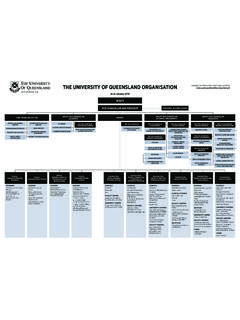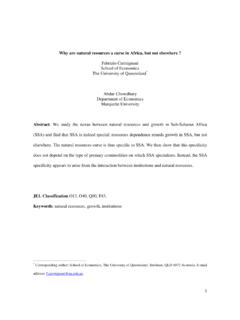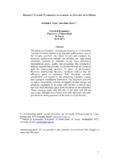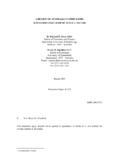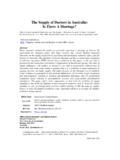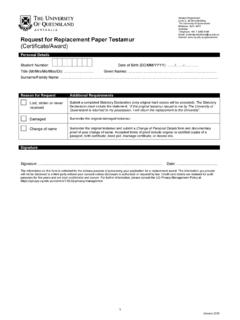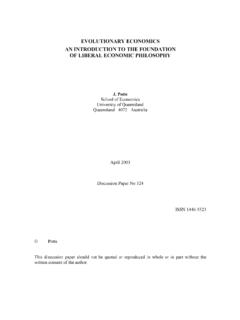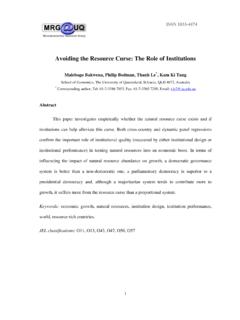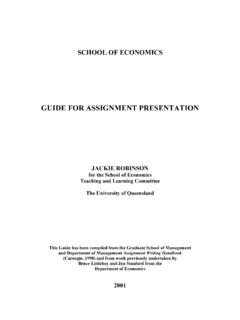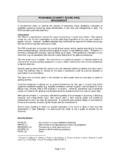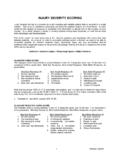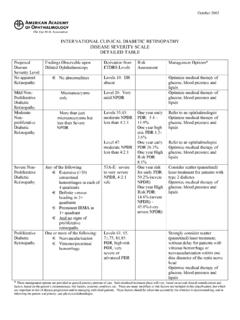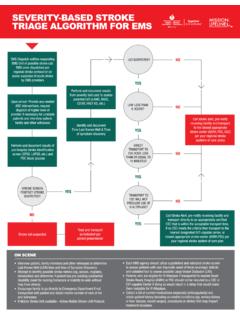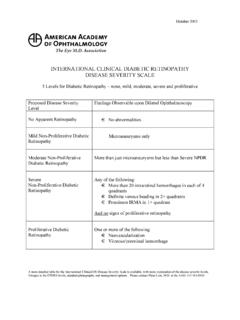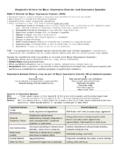Transcription of Certainty of Punishment versus Severity of …
1 Certainty of Punishment versus Severity of Punishment : An Experimental Investigation Lana Friesen, School of Economics Discussion Paper No. 400, October 2009, School of Economics, The University of Queensland. Australia. Full text available as: PDF- Requires Adobe Acrobat Reader or other PDF viewer Abstract Compliance with laws and regulations depends on the expected penalty facing violators. The expected penalty depends on both the probability of Punishment and the Severity of the Punishment if caught. A key question in the economics of crime literature is whether increasing the probability of Punishment is a more effective deterrent than an equivalent increase in the Severity of Punishment . This paper uses laboratory experiments to investigate this issue, and finds that increasing the Severity of Punishment is a more effective deterrent than an equivalent increase in the probability of Punishment .
2 This result contrasts with the findings of the empirical crime literature. EPrint Type: Departmental Technical Report Keywords: regulatory compliance, experiment, enforcement, penalty Subjects: ID Code: JEL Classification: C91, K42, L51, Q58. Deposited By: Lana Friesen University of Queensland School of Economics Brisbane, QLD 4072. Certainty of Punishment versus Severity of Punishment : An Experimental Investigation Lana Friesen*. October 2009. Abstract Compliance with laws and regulations depends on the expected penalty facing violators. The expected penalty depends on both the probability of Punishment and the Severity of the Punishment if caught. A key question in the economics of crime literature is whether increasing the probability of Punishment is a more effective deterrent than an equivalent increase in the Severity of Punishment .
3 This paper uses laboratory experiments to investigate this issue, and finds that increasing the Severity of Punishment is a more effective deterrent than an equivalent increase in the probability of Punishment . This result contrasts with the findings of the empirical crime literature. JEL codes: C91, K42, L51, Q58. Keywords: regulatory compliance, experiment, enforcement, penalty * School of Economics, University of Queensland, Brisbane, Qld 4072, Australia. Email: 1. 1. Introduction Compliance with laws and regulations depends on the expected penalty facing violators. The expected penalty depends on both the probability of Punishment and the Severity of the Punishment if caught. A key question in the economics of crime literature is whether increasing the probability of Punishment is a more effective deterrent than an equivalent increase in the Severity of Punishment .
4 The answer to this question has implications for the design of enforcement strategies and, in particular, for the allocation of limited resources. Should additional resources be devoted to catching violators or to punishing them? This issue is important not just for policing criminal law, but also for the enforcement of a wide range of laws and regulations including environmental, occupational health and safety, and traffic regulations, as well as tax, fraud, and antitrust laws. The seminal work in the economics of crime and enforcement literature is Becker (1968). In his model, rational decision makers compare the expected gain from offending with the expected penalty from offending. Becker (1968) identifies the key role of risk preferences. In particular, risk neutral individuals consider only the expected penalty and not its composition, and are therefore indifferent to offsetting changes in the probability and Severity of Punishment that keep the expected penalty constant.
5 Risk averse individuals, on the other hand, are deterred more by (equivalent) increases in Severity of Punishment , while risk lovers are deterred more by (equivalent) increases in the probability of detection. Despite the fact that many extensions have been made to Becker's (1968) theoretical model (Polinksy and Shavell, 2000, summarise these developments), the relatively efficacy of violation detection versus Severity remains an unresolved question. Empirical evidence has largely come from general crime data. The consensus of results from this literature (summarised by Eide, 2000) supports the general theory of deterrence. That is, increases in variables such as the probability of detection and conviction, along with increases in the penalty (either fines or jail terms) tend to reduce crime rates. Comparing the magnitude of the impacts, increases in the probability of Punishment have a larger and more significant impact than increases in the Severity of Punishment .
6 The results of these studies however are often controversial because of the nature of the data used. Data can be either individual level or at an aggregate ( state) level. Individual level data is either sourced 2. from the criminal justice system, creating sample selection issues ( the data set in Grogger, 1991, includes only those with a history of past offenses), or based on self-reported data. If aggregate level data is used, the potential endogeneity of the crime rate and enforcement parameters, such as the probability of detection, must be accounted for. Regardless of the type of data, all of these empirical studies have to construct measures of the probability and Severity of Punishment that are proxies based on past data, as well as being estimated without knowledge of the true level of offending. These constructed measures will also differ from individual perceptions of both the likelihood of being caught and the likely Punishment if arrested.
7 Because of these data controversies, less credence is given to comparisons of the relative magnitudes of the effects of increasing probability and Severity than to the fact that both have a negative impact on crime. This leads Polinsky and Shavell (2000, , emphasis added) to conclude their survey of the economic theory of public enforcement of law with the following statement: [e]mpirical work on law enforcement is strongly needed to better measure the deterrent effects of sanctions, especially to separate the influence of the magnitude of sanctions from their probability of application.. Empirical studies on regulatory enforcement are fewer. These studies must also rely on constructed measures of the key variables, and in the case of environmental enforcement, penalty information was not available until recent studies. For example, Gray and Deily (1996) find that enforcement actions increase compliance among steel making plants, however their analysis includes no data on fines and the enforcement measure is number of actions taken during the previous two years.
8 Stafford (2002) estimates the impact of an increase in fines for hazardous waste violations using an indicator variable for pre- and post- change years. Recent work by Shimshack and Ward (2005) on water pollution includes data on past penalties and inspections. Using plant level self-reported data, they find that (past). fines are a more successful deterrent than This paper takes a different approach and uses laboratory experiments to investigate whether (equivalent) changes in the probability or Severity of Punishment have a larger impact on compliance behaviour. The use of a controlled laboratory setting can overcome some of the 1. The inspection measure is the number of inspections at the plant within the last year, while the fine measure is a dummy variable indicating if any firm was fined in the preceding 12 months. 3.
9 Data issues that hamper empirical studies. In particular, individual compliance decisions are directly observed, and the probability and Severity of Punishment is varied in a controlled manner that keeps the expected penalty constant. In addition, the direction of causality is clear, and individual perceptions of the likelihood of detection and size of potential penalties are unlikely to deviate substantially from the experimental parameters. Despite the recent growth of experimental economics as a field, there are only a few enforcement experiments and even fewer that consider the relative efficacy of probabilities versus Severity of Punishment . Experiments on regulatory enforcement more generally are Clark, Friesen and Muller (2004) and Cason and Gangadharan (2006a); Murphy and Stranlund (2008) who focus on self-auditing and self-reporting; and Murphy and Stranlund (2007) and Cason and Gangadharan (2006b) on the enforcement of emissions trading schemes.
10 Although not the focus of their paper, Murphy and Stranlund (2007) include two treatments with the same expected penalty, but vary the probability of detection from low . to high . They find that compliance is unaffected by this change. To my knowledge, there are only two published economics experiments that focus on the effects of probability versus Severity of Block and Gerety (1995) conduct an antitrust experiment with a unique subject pool prisoners along with a second standard subject pool of students. They find that students are more responsive to increases in the fine compared with equivalent increases in the probability of detection, a result consistent with risk aversion. On the other hand, prisoners respond more to increases in the probability of detection, a result consistent with being risk lovers. Anderson and Stafford (2003) use a public goods experiment where free-riding is punished, and find intriguing evidence that subject contributions respond more to Punishment Severity than to Punishment probability.
